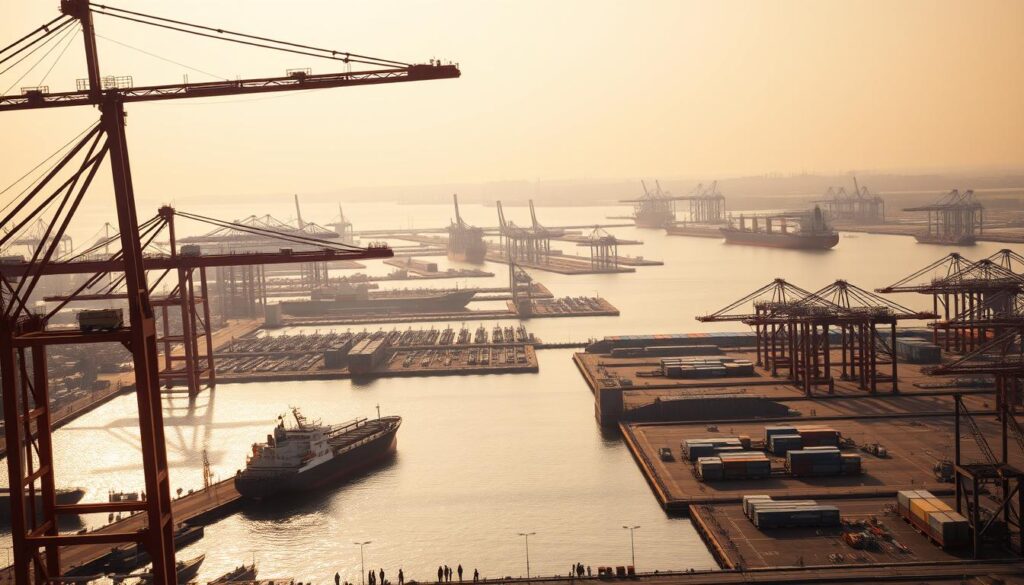Can the world’s busiest ports maintain their efficiency and keep up with the ever-growing demands of global trade? The answer lies in mastering port engineering and leveraging cutting-edge marine infrastructure.
Efficient maritime operations are crucial for international trade, with ports serving as vital hubs for the transportation of goods. However, maintaining and developing marine infrastructure is a complex task that requires careful planning and expertise.
By optimizing port operations and investing in innovative technologies, ports can improve their efficiency, reduce costs, and enhance their overall competitiveness.
Key Takeaways
- Efficient port operations are critical for global trade.
- Mastering port engineering is essential for maintaining and developing marine infrastructure.
- Investing in innovative technologies can improve port efficiency and competitiveness.
- Optimizing port operations can reduce costs and enhance overall performance.
- Ports must adapt to growing demands and evolving trade patterns.
Understanding the Basics of Port Engineering
Port engineering is a critical discipline that underpins the efficiency and safety of maritime operations worldwide. It involves the design, construction, and maintenance of ports, which are complex infrastructures requiring meticulous planning and execution.
What is Port Engineering?
Port engineering encompasses the application of engineering principles to the development and operation of ports. This includes the design of port infrastructure such as berths, wharfs, and terminals, as well as the implementation of systems for cargo handling and navigation. Effective port engineering is crucial for facilitating global trade and economic development.
For instance, the transportation network engineering plays a vital role in ensuring that ports are well-integrated with other transportation modes, enhancing their efficiency and connectivity.
Key Components of Port Infrastructure
The infrastructure of a port is composed of several key components, each serving a specific function. These include:
- Berths and wharfs where ships dock and cargo is handled.
- Terminals for processing and storing cargo.
- Navigation channels and aids to ensure safe passage for vessels.
A well-designed port infrastructure is essential for the smooth operation of maritime activities. For example, the use of advanced marine electronics in navigation aids has significantly improved the safety and efficiency of port operations.
| Component | Function | Importance |
|---|---|---|
| Berths and Wharfs | Docking and cargo handling | High |
| Terminals | Cargo processing and storage | High |
| Navigation Channels | Safe passage for vessels | Critical |
The Role of Port Engineers
Port engineers play a vital role in the development and maintenance of port infrastructure. Their responsibilities include designing and overseeing the construction of new facilities, as well as ensuring that existing infrastructure remains safe and operational. This involves staying abreast of the latest technologies and trends in port engineering, such as the use of automation and digitalization in port operations.
The work of port engineers is crucial for the success of port operations, impacting not only the local economy but also global trade. As such, their role is integral to the broader context of coastal development and economic growth.
Importance of Ports in Global Trade
Global trade relies heavily on efficient port operations, which drive economic growth and development. Ports are not just critical infrastructure; they are also significant economic drivers, supporting a wide range of activities from cargo handling to logistics and shipping.
Economic Impact of Maritime Operations
The economic impact of maritime operations is substantial. According to various studies, ports contribute significantly to national and regional economies by creating jobs, generating revenue, and stimulating economic activity. For instance, a study on the economic benefits of ports in the United States highlighted their role in supporting over 26 million jobs and contributing to the GDP through maritime trade.
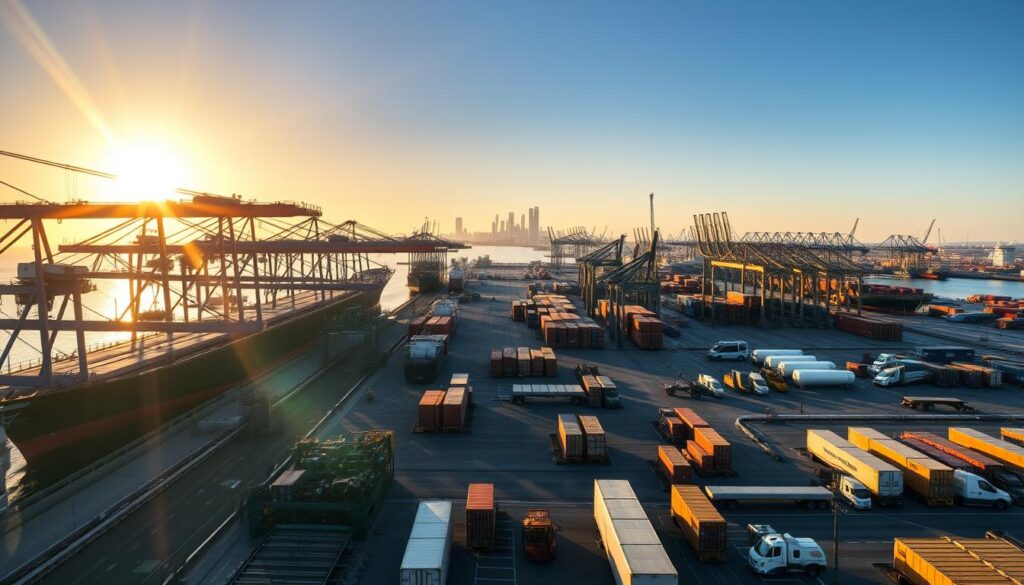
| Economic Indicator | Impact | Percentage Contribution |
|---|---|---|
| Job Creation | 26 million jobs | 2.5% |
| GDP Contribution | $1.4 trillion | 5% |
| Revenue Generation | $320 billion | 1.2% |
Ports as Logistics Hubs
Ports serve as vital logistics hubs, facilitating the efficient transfer of goods between different modes of transport, such as ships, trucks, and trains. The integration of advanced technologies, including automation and data analytics, has enhanced the efficiency of terminal operations, making ports more competitive and attractive to shipping lines and logistics companies.
Efficient terminal operations are crucial for reducing transit times and costs, thereby improving the overall competitiveness of ports in global trade. Moreover, the development of waterfront construction projects has enabled the expansion of port facilities, allowing for the accommodation of larger vessels and increased cargo volumes.
The Future of Global Trade
The future of global trade is closely tied to the evolution of port infrastructure and operations. As global trade patterns continue to shift, ports must adapt to changing demands, including the need for more sustainable and environmentally friendly operations. The adoption of green technologies and practices is becoming increasingly important, with ports investing in initiatives such as shore power, renewable energy, and green infrastructure.
In conclusion, ports play a vital role in global trade, driving economic growth and development. Their function as logistics hubs, coupled with their economic impact, underscores their importance in the global economy. As the landscape of global trade continues to evolve, the adaptability and innovation of ports will be crucial in meeting future challenges and opportunities.
Types of Ports and Their Functions
Understanding the different types of ports is crucial for appreciating their role in international trade and commerce. Ports are vital infrastructure that facilitates the exchange of goods and services across the globe.
“Ports are the backbone of global trade, enabling the efficient movement of goods across the world,” said John Smith, a maritime expert. This statement underscores the importance of ports in the global economy.
Container Ports vs. Bulk Ports
Container ports and bulk ports are two of the most common types of ports. Container ports specialize in handling containerized cargo, which is transported in large shipping containers. These ports are equipped with cranes and other machinery designed to efficiently load and unload containers from ships.
Bulk ports, on the other hand, handle bulk cargo such as grains, minerals, and oil. These ports are designed to handle large volumes of cargo and often have specialized equipment for loading and unloading bulk materials.
A notable example of a container port is the Port of Singapore, known for its efficiency and high-volume container handling capabilities. In contrast, the Port of Rotterdam is a significant bulk port, handling large quantities of crude oil and other bulk commodities.
Fishing Ports and Passenger Terminals
Fishing ports are specialized ports that cater to the fishing industry. They provide facilities for landing, processing, and distributing fish and other seafood. These ports are crucial for the livelihood of fishing communities and the supply of fresh seafood to markets.
Passenger terminals, on the other hand, are designed to handle passenger traffic, including cruise ships and ferries. These terminals provide amenities for travelers and are often integrated with other transportation networks.
The Port of Miami is a prominent example of a passenger terminal, serving as a major cruise ship hub in the United States.
Specialized Ports: A Deeper Dive
Specialized ports are designed to handle specific types of cargo or serve particular industries. Examples include offshore ports for oil and gas operations, and ports specialized in handling oversized or heavy cargo.
These ports often require unique infrastructure and equipment tailored to their specific needs. For instance, a port handling liquefied natural gas (LNG) will have specialized storage facilities and handling equipment.
The use of advanced technologies, such as automation and predictive analytics, is becoming increasingly common in specialized ports to enhance efficiency and safety.
“The future of port operations lies in embracing technology and innovation to meet the evolving demands of global trade,” noted Jane Doe, a port engineering expert.
By understanding the different types of ports and their functions, we can appreciate the complexity and importance of port infrastructure in facilitating global trade and commerce.
Design Principles in Port Engineering
The design principles applied in port engineering play a significant role in determining the efficiency and safety of port operations. Effective port design not only enhances the operational capacity of ports but also ensures compliance with safety and environmental standards.

Safety Standards in Port Design
Safety is a paramount consideration in port engineering. Ports must be designed to prevent accidents and minimize risks to personnel, cargo, and the environment. This involves implementing robust safety standards, including the use of appropriate signage, safety equipment, and emergency response plans. Proper safety protocols are essential for mitigating hazards associated with port operations, such as cargo handling and vessel navigation.
Moreover, safety standards in port design must be regularly updated to reflect new technologies and best practices. This includes training personnel on the latest safety procedures and ensuring that all equipment is well-maintained.
Environmental Considerations
Environmental considerations are increasingly important in port engineering. Ports must be designed to minimize their environmental footprint, including reducing emissions, managing waste, and protecting local ecosystems. Efficient port design can significantly reduce the environmental impact of port operations, contributing to more sustainable maritime practices.
Ports are also encouraged to adopt green technologies and practices, such as using renewable energy sources and implementing energy-efficient lighting. These measures not only benefit the environment but can also result in cost savings for port operators.
The Impact of Weather and Tides
Weather and tidal conditions have a significant impact on port design. Ports must be engineered to withstand various weather conditions, including storms and extreme temperatures, as well as tidal fluctuations. Understanding these factors is crucial for designing ports that are resilient and capable of operating under a range of conditions.
Designing ports with consideration for weather and tides involves complex engineering calculations and modeling. It requires a deep understanding of local hydrological and meteorological conditions to ensure that ports remain operational and safe under various environmental scenarios.
Advanced Technologies in Port Engineering
The future of port engineering is being shaped by the adoption of advanced technologies such as automation and predictive analytics. These innovations are transforming traditional port operations, making them more efficient, safe, and environmentally friendly.
Automation in Port Operations
Automation is revolutionizing port operations by streamlining processes, reducing labor costs, and enhancing productivity. Automated container handling systems, for instance, are being increasingly adopted to manage cargo efficiently. According to a report, the global automated container terminal market is expected to grow significantly, driven by the need for faster and more reliable cargo handling.
Key Benefits of Automation:
- Increased Efficiency
- Reduced Labor Costs
- Enhanced Safety
Use of Drones in Port Surveillance
Drones are being utilized in ports for surveillance, inspection, and monitoring of port facilities. They provide real-time data, enhancing security and operational efficiency. For example, drones equipped with thermal imaging cameras can detect anomalies in cargo or equipment, allowing for swift action.
Predictive Analytics for Port Management
Predictive analytics is being used to forecast demand, manage maintenance, and optimize resource allocation in ports. By analyzing historical data and real-time information, ports can make informed decisions, reducing downtime and improving overall efficiency. For more insights on top port technologies, visit this blog.
| Technology | Application | Benefits |
|---|---|---|
| Automation | Cargo Handling | Increased Efficiency, Reduced Labor Costs |
| Drones | Surveillance and Inspection | Enhanced Security, Real-time Monitoring |
| Predictive Analytics | Maintenance and Resource Allocation | Reduced Downtime, Improved Efficiency |
Sustainability Practices in Port Operations
With the growing emphasis on environmental protection, ports are increasingly adopting sustainable practices to reduce their ecological footprint. Sustainability in port operations is not just about reducing environmental impact; it’s also about enhancing economic viability through efficient operations and reduced costs.
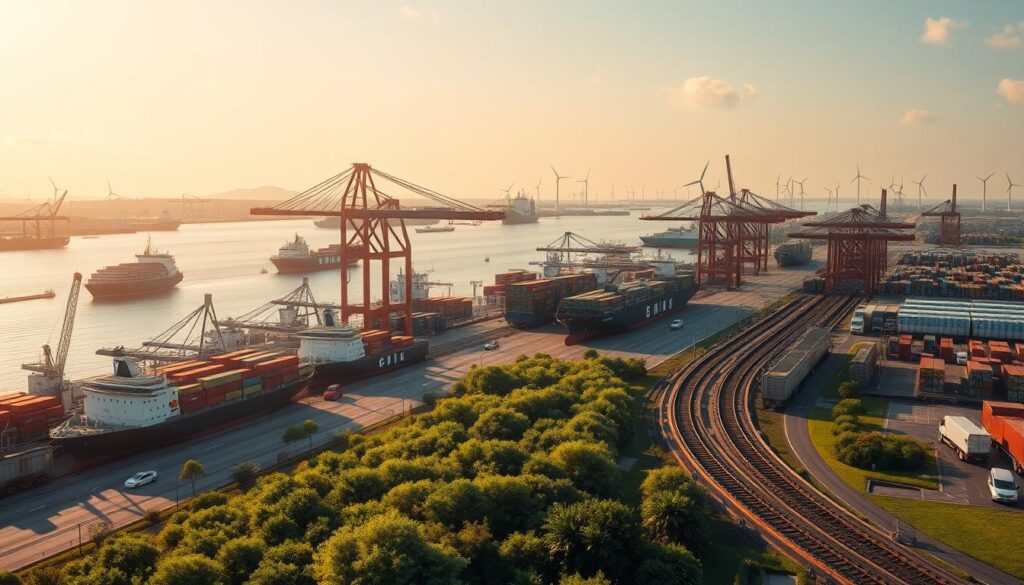
Green Port Initiatives
Ports around the world are implementing green port initiatives to minimize their environmental impact. These initiatives include the use of renewable energy sources, such as wind and solar power, to reduce dependence on fossil fuels. For instance, the Port of Los Angeles has implemented a Clean Air Action Plan that includes measures to reduce emissions from ships, trucks, and trains.
“The shift towards green ports is not just a trend; it’s a necessity for the future of our planet,” said a spokesperson for the American Association of Port Authorities.
Reducing Carbon Footprint in Ports
Reducing the carbon footprint in ports involves a multifaceted approach, including the adoption of cleaner fuels, optimization of vessel scheduling, and the use of electric or hybrid equipment for cargo handling. The Port of Rotterdam, for example, has introduced a zero-emission policy for its inland shipping and has invested in shore power facilities to allow ships to turn off their engines while docked.
- Implementing energy-efficient lighting and systems
- Using electric or hybrid cranes and other cargo handling equipment
- Optimizing vessel scheduling to reduce fuel consumption
Waste Management Solutions
Effective waste management is crucial for sustainable port operations. This includes implementing recycling programs, reducing waste generation, and ensuring proper disposal of hazardous materials. The Port of Singapore, known for its efficient operations, has implemented a comprehensive waste management system that includes recycling and waste-to-energy initiatives.
As ports continue to adopt sustainable practices, the industry is likely to see significant reductions in environmental impact. By embracing green technologies and sustainable operations, ports can not only comply with environmental regulations but also enhance their economic competitiveness.
Challenges Faced in Port Engineering
Effective port engineering requires overcoming several obstacles. Port engineers and operators must navigate a complex array of challenges to ensure efficient and safe maritime operations.
Navigational Hazards
Navigational hazards pose a significant threat to port operations. These hazards include shallow waters, narrow channels, and adverse weather conditions, which can lead to accidents and disrupt the flow of cargo. To mitigate these risks, port engineers implement various safety measures, such as advanced navigation systems and predictive analytics for weather forecasting.
Infrastructure Aging and Maintenance
Aging infrastructure is another major challenge in port engineering. As ports age, their infrastructure requires regular maintenance and upgrades to remain operational. This includes the repair of docks, cranes, and other critical equipment. Effective port maintenance strategies are essential to minimize downtime and ensure the continued efficiency of port operations.
Compliance with Regulatory Frameworks
Ports must comply with a myriad of regulatory frameworks, including environmental, safety, and security regulations. Compliance with these regulations requires significant investment in regulatory compliance measures and ongoing monitoring. Port engineers must stay up-to-date with changing regulations and implement necessary adjustments to maintain compliance.
By understanding and addressing these challenges, port engineers can develop effective solutions to enhance the efficiency, safety, and sustainability of port operations.
Economic Factors Influencing Port Engineering
Understanding the economic factors that influence port engineering is crucial for the development of efficient maritime operations. Ports are significant economic hubs, contributing to national and regional economies through job creation, trade facilitation, and revenue generation.
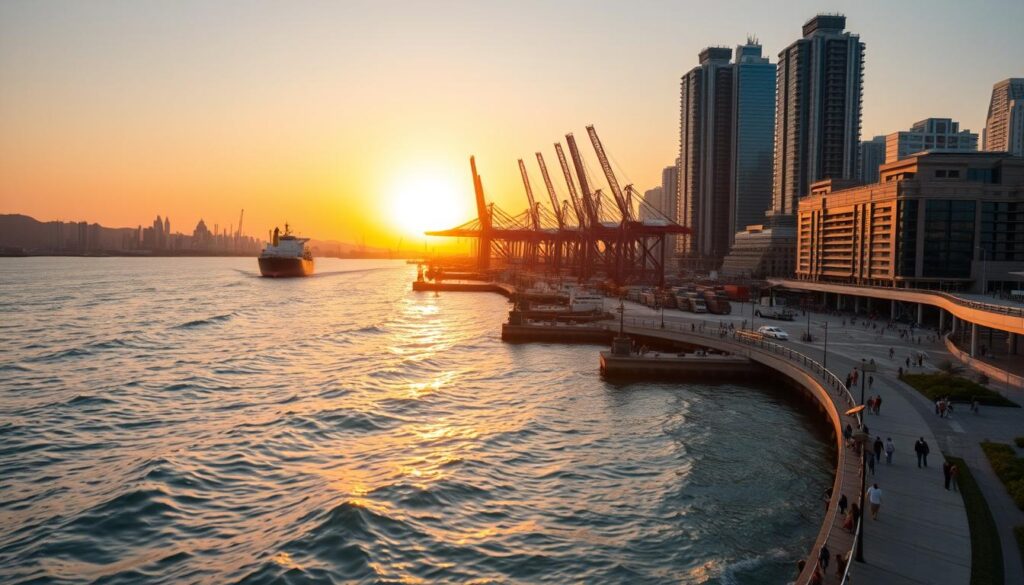
The economic landscape of ports is influenced by several key factors, including investment trends, trade policies, and financing options for port projects. Investment in port infrastructure is critical for maintaining competitiveness and accommodating larger vessels and increased cargo volumes.
Investment Trends in Port Development
Investment trends in port development are shifting towards more sustainable and technologically advanced infrastructure. There’s a growing emphasis on green port initiatives that reduce environmental impact while enhancing operational efficiency. According to recent trends, ports are investing heavily in automation and digitalization to streamline terminal operations.
For more information on how ports are adapting to economic changes, visit Port Economics Management for insights into port and economic development.
The Impact of Trade Wars on Ports
Trade wars can significantly impact port operations and development. Tariffs and trade restrictions can alter shipping routes and volumes, affecting the economic viability of certain ports. For instance, a trade war might divert cargo from one port to another, necessitating adjustments in infrastructure and operations.
Understanding these dynamics is crucial for port engineers and policymakers to anticipate and mitigate the effects of trade disruptions. For a deeper dive into managing construction costs, which can be affected by trade wars, refer to Cutting Construction Costs in Africa: A.
Financing Port Engineering Projects
Financing is a critical aspect of port engineering projects. Various financing models are available, including public-private partnerships (PPPs), government grants, and loans from international financial institutions. The choice of financing model can significantly impact the project’s viability and the port’s subsequent operational costs.
Effective financing strategies are essential for the successful completion of port projects, ensuring that they are completed on time and within budget. This is particularly important for large-scale projects involving coastal development and significant infrastructure upgrades.
Collaboration Among Stakeholders
In the realm of port engineering, collaboration is not just beneficial; it’s essential for achieving project goals. Effective collaboration ensures that all aspects of port development are considered, from economic viability to environmental impact.
Importance of Public-Private Partnerships
Public-private partnerships (PPPs) have emerged as a crucial mechanism for financing and delivering port infrastructure projects. By leveraging the strengths of both sectors, PPPs can bring about efficiency and innovation to port development. For instance, the partnership between the Port of Los Angeles and private operators has led to significant advancements in container handling technology, enhancing the port’s competitiveness.
Engaging Local Communities
Engaging with local communities is vital for the success of port projects. It not only helps in addressing concerns related to noise, pollution, and traffic but also fosters a sense of ownership among community members. The Port of Seattle, for example, has implemented various initiatives to engage with local communities, including regular town hall meetings and environmental stewardship programs.
Working with Regulatory Bodies
Compliance with regulatory frameworks is a critical aspect of port engineering. Working closely with regulatory bodies ensures that port developments meet all necessary standards and regulations. The U.S. Army Corps of Engineers plays a pivotal role in this regard, providing expertise in navigation and coastal engineering. Collaboration with such bodies helps in navigating the complex regulatory landscape, ensuring that projects are both compliant and sustainable.
By fostering collaboration among stakeholders, including public-private partnerships, community engagement, and regulatory compliance, port engineering projects can achieve their full potential, contributing to economic growth and environmental sustainability.
Innovations Shaping the Future of Port Engineering
The future of port engineering is being shaped by technological innovations that promise to enhance efficiency and reduce environmental impact. As the maritime industry continues to evolve, ports are adopting various cutting-edge technologies to stay ahead.
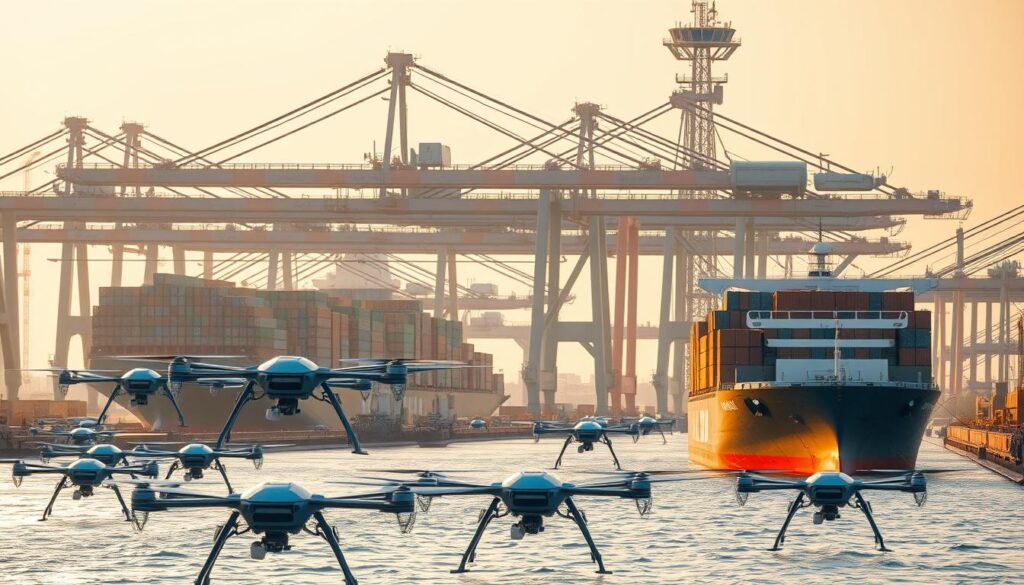
Smart Ports and IoT Applications
One of the significant innovations in port engineering is the development of smart ports, which utilize Internet of Things (IoT) applications to enhance operational efficiency. IoT devices can monitor and manage various aspects of port operations, from crane movements to inventory management, making ports more efficient and reducing downtime.
For more insights on how technology is transforming port operations, visit Port Infrastructure Innovations.
Blockchain in Supply Chain Management
Blockchain technology is another innovation making waves in the maritime industry. By providing a secure and transparent way to track shipments, blockchain can help reduce fraud and increase the efficiency of supply chain management. This technology has the potential to revolutionize the way ports handle cargo, making the process more reliable and streamlined.
Future Trends in Maritime Technology
Looking ahead, the maritime industry is expected to see significant advancements in maritime technology, including the use of artificial intelligence (AI) and autonomous vessels. These technologies promise to further enhance the efficiency and safety of port operations. For example, AI can be used to predict and prevent maintenance needs, while autonomous vessels can improve navigation and reduce the risk of accidents.
To learn more about how AI is transforming civil engineering, check out How AI is Transforming Civil Engineering.
Port Security Measures and Protocols
As global trade continues to evolve, the need for comprehensive port security measures has become increasingly paramount. Ports are critical infrastructure for international trade, handling millions of containers and thousands of passengers daily. Ensuring their security is not just a matter of national safety but also of global economic stability.
Cybersecurity in Port Operations
Cybersecurity is a critical aspect of modern port security. With the increasing reliance on digital systems for operations, ports are vulnerable to cyber threats. Implementing robust cybersecurity measures, such as firewalls, intrusion detection systems, and regular software updates, is essential to protect against these threats.
Key cybersecurity practices include:
- Conducting regular risk assessments
- Implementing multi-factor authentication
- Providing ongoing training for personnel
Physical Security Measures
Physical security is another vital component of port security. This includes measures such as access control, surveillance systems, and perimeter fencing. Effective physical security deters potential threats and ensures the safety of personnel, cargo, and infrastructure.
Best practices for physical security involve:
- Utilizing advanced surveillance technology
- Implementing strict access control protocols
- Conducting regular security audits
Emergency Response Planning
Despite the best preventive measures, emergencies can still occur. Having a comprehensive emergency response plan in place is crucial. This plan should include procedures for various scenarios, such as natural disasters, terrorist attacks, or industrial accidents.
Key elements of an emergency response plan include:
- Clear communication protocols
- Defined roles and responsibilities
- Regular drills and training exercises
In conclusion, securing ports is a multifaceted challenge that requires a combination of cybersecurity, physical security, and emergency response planning. By implementing these measures, ports can ensure the safety and efficiency of their operations, supporting the broader goals of global trade and economic stability.
The Role of Logistics in Port Engineering
The efficiency of port operations heavily relies on the effectiveness of logistics and supply chain management. Logistics is integral to ensuring that goods are handled, stored, and transported in a manner that is both efficient and cost-effective.
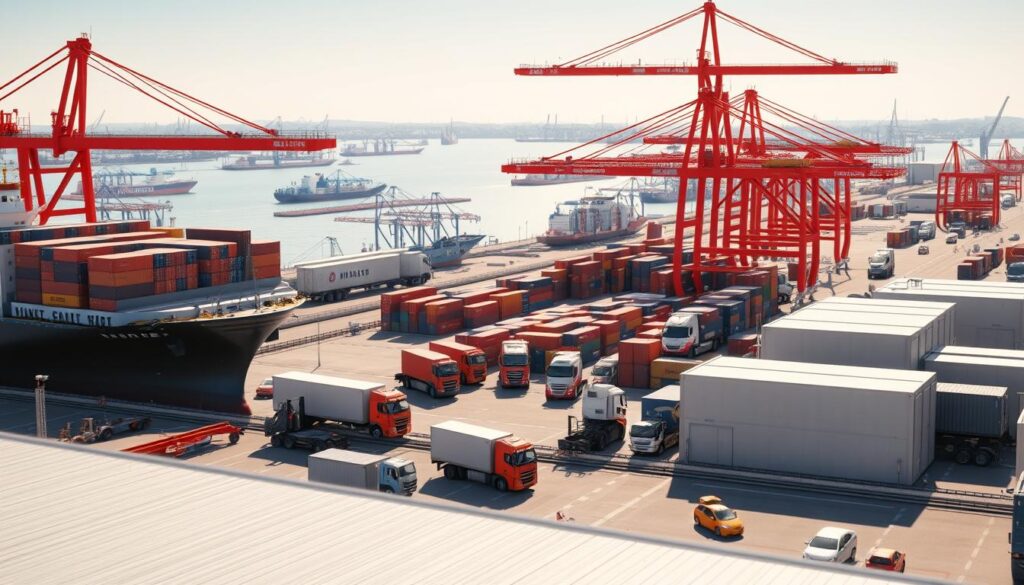
Supply Chain Optimization
Supply chain optimization is a critical aspect of logistics in port engineering. It involves streamlining processes to reduce delays and costs. Effective supply chain optimization can lead to improved terminal operations and reduced congestion.
According to a report by the American Association of Port Authorities, “Optimizing supply chain operations can significantly reduce transit times and costs, thereby enhancing the competitiveness of ports.” This underscores the importance of logistics in maintaining a competitive edge in global trade.
| Optimization Technique | Benefits | Impact on Port Operations |
|---|---|---|
| Streamlining Cargo Handling | Reduced Transit Times | Increased Efficiency |
| Implementing Advanced Technology | Improved Accuracy | Enhanced Productivity |
| Enhancing Intermodal Connections | Better Coordination | Reduced Congestion |
Intermodal Connections and Their Importance
Intermodal connections play a vital role in the logistics of port engineering. They enable the seamless transfer of goods between different modes of transport, such as ships, trucks, and trains. This integration is crucial for maintaining the flow of goods and reducing transit times.
“The future of port logistics lies in the ability to integrate different modes of transport efficiently, ensuring that goods reach their destination quickly and reliably.”
Efficient Cargo Handling Techniques
Efficient cargo handling is another key aspect of logistics in port engineering. It involves the use of advanced equipment and techniques to handle cargo quickly and safely. This not only reduces the risk of damage but also improves the overall efficiency of port operations.
Best practices in cargo handling include:
- Utilizing automated cranes and container handling equipment
- Implementing real-time tracking systems
- Training personnel in efficient handling techniques
By focusing on these areas, ports can enhance their operational efficiency and maintain a competitive edge in the global market.
Training and Development in Port Engineering
As global trade continues to evolve, the importance of well-trained port engineers cannot be overstated. The complexity of port operations demands a highly skilled workforce capable of managing the intricacies of modern ports.
Educational Programs Available
Several educational programs are available for aspiring port engineers. These programs cover a wide range of topics, from the fundamentals of port engineering to advanced courses in port planning and coastal development. For instance, the Port Engineering Certificate Program offered by the American Society of Civil Engineers (ASCE) provides comprehensive training in port engineering principles.
Some of the key areas covered in these programs include:
- Design and construction of port infrastructure
- Operations and management of port facilities
- Environmental considerations in port development
Professional Certifications for Engineers
Professional certifications play a crucial role in the development of port engineers. Certifications such as the Certified Port Engineer (CPE) designation demonstrate an engineer’s expertise and commitment to their profession. These certifications often require a combination of education, experience, and passing a rigorous examination.
The benefits of professional certifications include:
| Benefit | Description |
|---|---|
| Enhanced Credibility | Certifications are recognized industry-wide, enhancing an engineer’s credibility. |
| Career Advancement | Certified engineers often have better career prospects and opportunities for advancement. |
| Staying Current | The process of obtaining and maintaining certification helps engineers stay current with the latest developments in their field. |
Importance of Continuous Learning
The field of port engineering is constantly evolving, with new technologies and methodologies being introduced regularly. Continuous learning is essential for port engineers to stay abreast of these developments and maintain their competence.
Continuous learning opportunities include workshops, seminars, and online courses. These opportunities allow engineers to expand their knowledge and skills, ensuring they remain effective in their roles.
Case Studies in Successful Port Engineering
Successful port engineering projects are pivotal in enhancing the efficiency and safety of ports, contributing to the global economy. By examining notable case studies, we can gain insights into the best practices and challenges faced in the field.
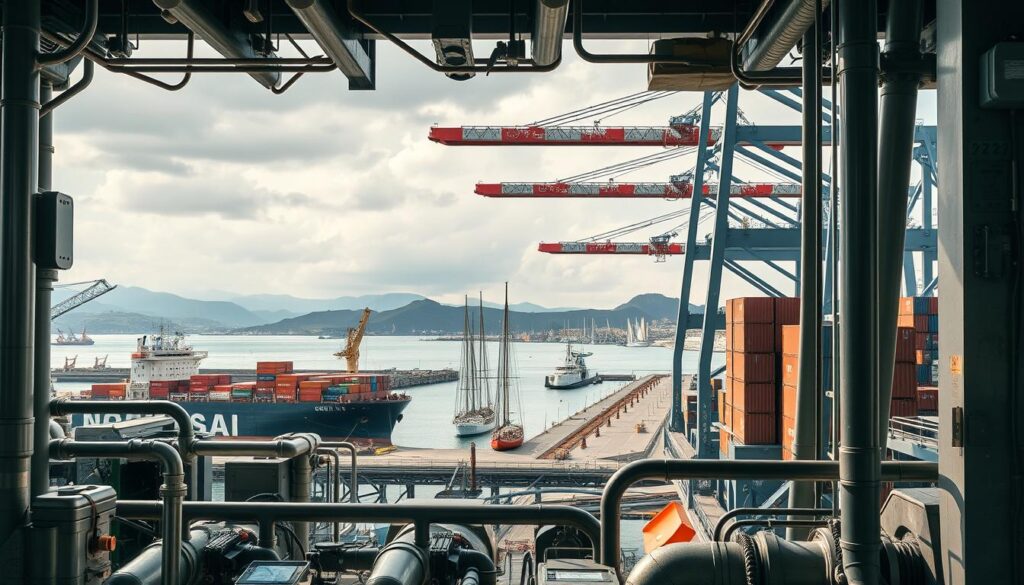
Notable Port Projects in the U.S.
The United States has seen numerous successful port engineering projects. For instance, the Port of Los Angeles has implemented various initiatives to enhance its operational efficiency, including the use of advanced technology for cargo handling and green port initiatives to reduce environmental impact.
Another example is the Port of Savannah, which has undergone significant expansion to accommodate larger vessels and increased cargo volume. This project involved substantial engineering efforts to deepen the harbor and enhance terminal facilities.
Lessons Learned from Failed Projects
While many port engineering projects are successful, there are also valuable lessons to be learned from those that have faced challenges. For example, the expansion of the Port of Jakarta faced significant delays and cost overruns due to unforeseen geological issues and regulatory hurdles.
Analyzing such cases highlights the importance of thorough planning, including comprehensive risk assessment and stakeholder engagement, to mitigate potential issues in port engineering projects.
Innovative Solutions to Port Challenges
Innovation plays a crucial role in addressing the complex challenges faced by ports. The use of predictive analytics for maintenance and operations is one such innovation that has shown promise in enhancing efficiency and reducing downtime.
Additionally, the adoption of sustainable practices, such as the use of renewable energy sources and electrification of port equipment, is becoming increasingly important in reducing the environmental footprint of ports.
By embracing these innovative solutions, ports can not only overcome current challenges but also prepare for future demands and environmental considerations.
The Future of Port Engineering
As the maritime industry continues to evolve, port engineering is poised to play a critical role in shaping its future. The development of marine infrastructure and coastal development will be crucial in meeting the demands of global trade.
Emerging Trends
Predictions for port development indicate a shift towards more sustainable and efficient operations. This includes the integration of advanced technologies such as artificial intelligence and automation, as well as the adoption of green port initiatives. For more insights on the future of marine engineering, visit World Civil Society.
Climate Change and Trade Patterns
Ports must also adapt to the challenges posed by climate change, including rising sea levels and increased weather variability. Furthermore, evolving trade patterns will require ports to be agile and responsive to changing demands. Effective coastal development strategies will be essential in ensuring the resilience of port infrastructure.
By investing in marine infrastructure and embracing innovative solutions, the port engineering sector can drive growth and sustainability in the maritime industry.
